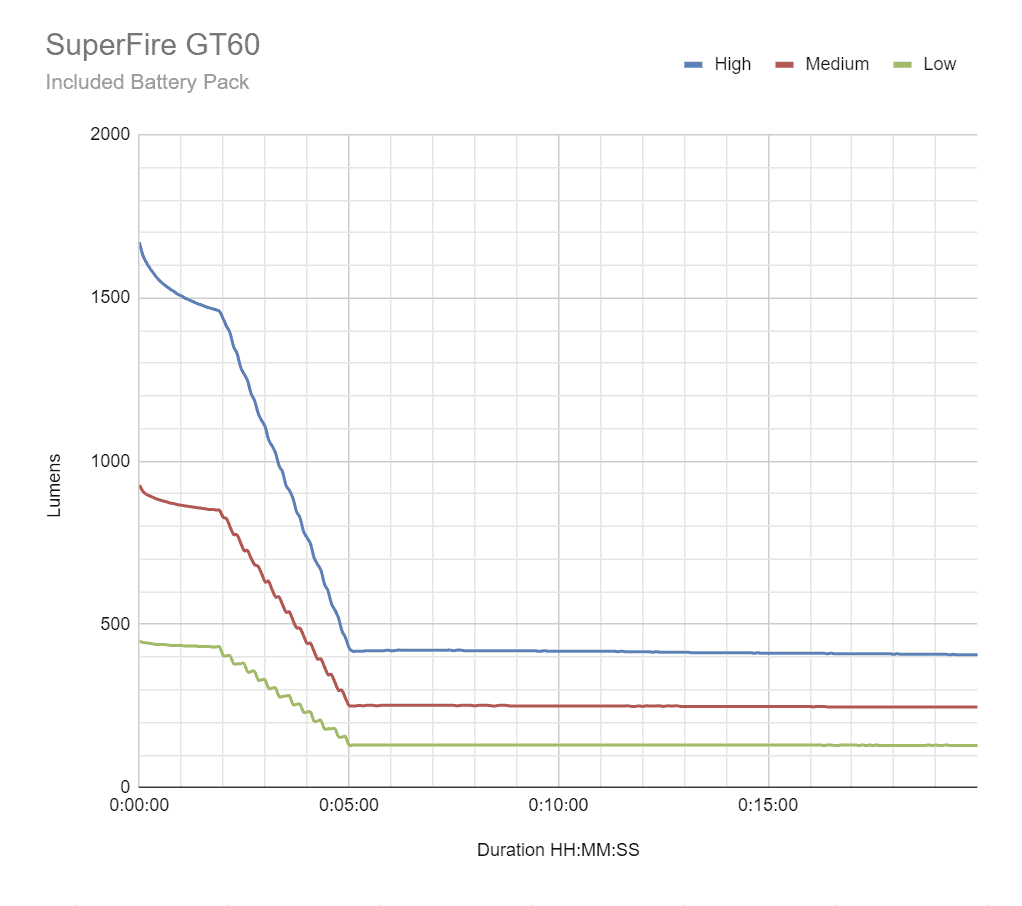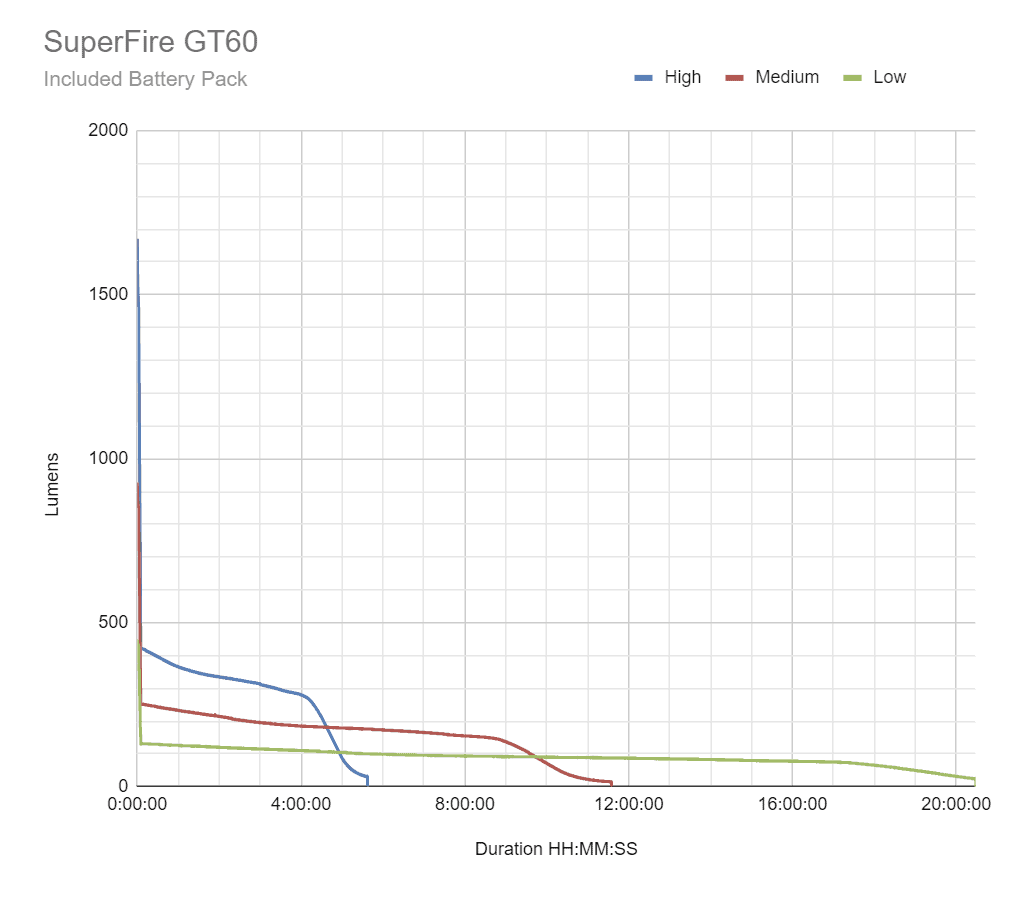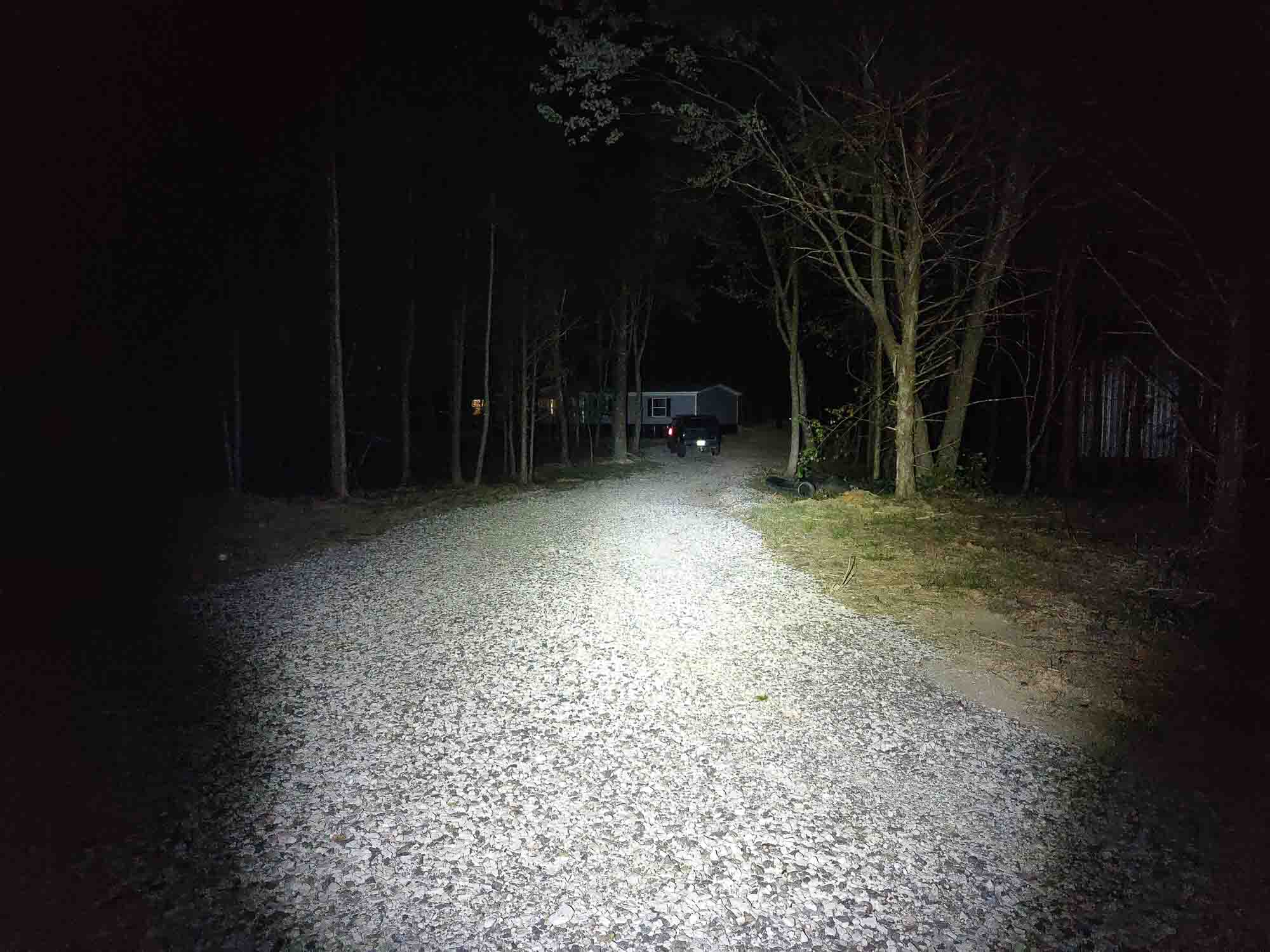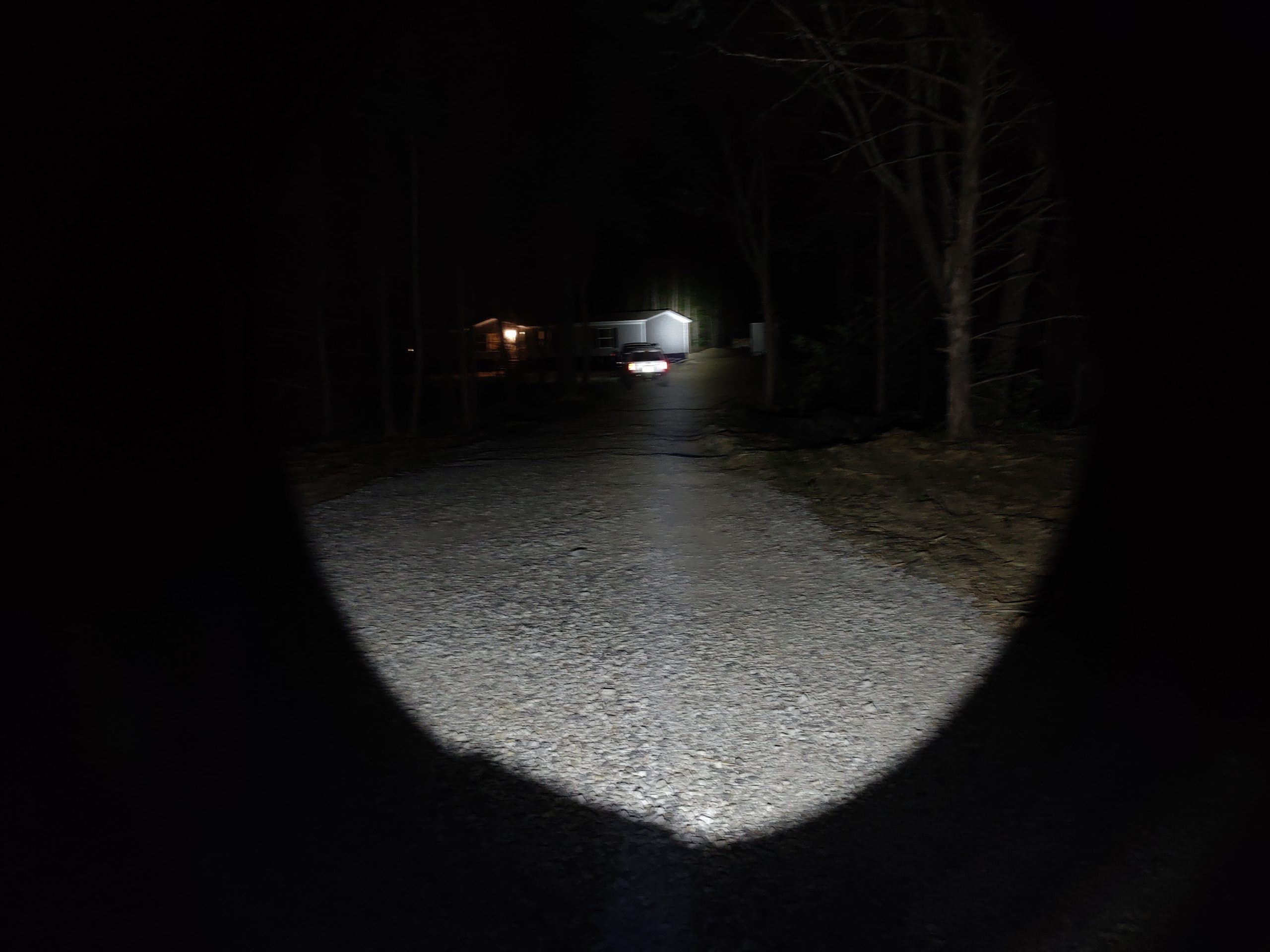1lumen selects and reviews products personally. We may earn affiliate commissions through our links, which help support our testing.
Superfire GT60 review: flashlight test

Superfire GT60 specifications
| Brand & Model | Superfire GT60 / Supfire GT60 |
|---|---|
| LED | XHP90?? |
| Lumens | 10,000 Lumens |
| Beam intensity | Not available |
| Battery config. | Proprietary Battery Pack |
| Onboard charging | USB-C |
| Modes | 5 |
| Blinkies | Strobe |
| Reflector | Aspheric Lens |
| Waterproof | IP34 |
| Review publication date | August 2022 |
SupFire GT60 Introduction:
I have heard a lot of slang pass by my ears in my “seasoned life”. One I have never personally used until now is “fire”. When the term “fire” is used, it is to indicate something is very good. UNLESS…. it comes up in the name of a flashlight. Angelfire, beamfire, crazyfire… the list goes on for awhile. Fire, in terms of flashlights, is usually an indicator of knockoff leds with exorbitant lumen claims and thin aluminum zoomies. Today, we get to explore the Superfire GT60 with 10,000 lumens. I will always remain hopeful of technology making a fool of me and surprising me with cost effectiveness and power. But, sometimes, claims can seem too good to be true. And, let’s get to the nitty gritty, shall we?
Package quality.
The GT60 comes in a color-printed cardboard box that is just larger than the light itself. What is unusual, is the box has the light listed as a “Supfire”, instead of a “Superfire”, although the product listing indicates Superfire. The light was not wrapped and squeezed next to it were the manual and the generic USB-C cable. No scratches came from not wrapping it, but I did notice quite a bit of grease underneath the head of the “Supfire” (Yes, the light is branded differently than the listing of the product as well). This lubricant/grease accompanied the cable as well.
Included in the package were:
- Superfire GT60
- USB-C cable
- Manual


Flashlight in use
The GT60, much to my surprise, actually feels quite good in the hand. I think because of the built-in battery pack and the additional size compared to most zoomies, this is actually quite a stout unit. It is a rather large light and thus, tail stands very easily.
The e-switch is very loud, each press alarming with a distinct *CLICK*. The bezel is slightly raised and makes it easy to identify without looking at the light. There is also another button on the bottom of the light that, when pressed, activates what is identified as a flood light. The flood light consists of 6 individual LEDs behind a diffused cover. They are positioned in a ring around the charging port and battery indicator. One thing missing from the base is holes for a lanyard. A lanyard was not provided with the light, although you may not want to carry such a large light all the time and a pocket clip on something this thick would look kind of silly. A lanyard would have been the best option, as it is nowhere near pocket-able.


Build Quality, and Warranty
The knurling has an unusual, but not terrible, design to it, where it has slightly raised sections on the handle (the same goes for the head). It is obviously intentional and the knurling matches quite well with the design of the e-switch on the body tube. The entire body and head are very evenly anodized in a matte black. Everything here actually looks pretty good. If you could ignore the labels blasted all over the head, this is a very decent looking light, assuming you keep the lens at its lowest point.
If you were to unthread up by the bezel or down by the “floodlight” or charging port, you would quickly realize that the build and the looks can be on very different levels. Unscrewing them shows you a higher than necessary gap in the threads and this makes the threads more on the rough side, even with the grease. There is also a residue on the lower threads, that appears to be a silicon sealant to help facilitate its water resistance rating. Everything works as it is intended to, but on the off chance you get one that doesn’t work as advertised, the warranty information is scarce. Their recommendation is to contact them. Nothing about a length of warranty coverage or anything of that nature.




LED, Lens, Bezel, Reflector, and Beam
If you look underneath the aluminum crenulated bezel and aspheric lens, you’ll see a rather large emitter not so sneakily hiding down there. Listed on the description as an XHP90, one has to assume this is a blatant knockoff of a CREE unit. On the CREE website they do not list an XHP90, and the closest to the lumen output I could find is an XHP35 unit. If it were an XHP35 unit, my guess is it would run much longer than it did (more on this in the performance section) as it would only be pulling 13W instead of 36W, as stated. It then becomes apparent this may be of the same footprint as a not yet released LED, but the efficiencies are lacking compared to more similarly powered options. But to some, an LED is an LED. It does work, but puts out far less than specified (also in the performance section) and gives you a rather cold white beam.
With the “Zoomie” aspect of the light, you are able to adjust the intensity by lengthening the light. A simple pull will transform the beam from a cool blue flood, completely free of hotspot, to a large LED silhouette on the wall that has literally zero spill. It is VERY concentrated. If you were wondering how cool the blue is, my Opple Lightmaster Pro tested the beam at just over 7000k in low mode at 3 feet. Also under that aspherical lens is a glow in the dark gasket for the bezel. It is a little further back than most I have seen and actually makes it loo quite nice. Not very “in your face” but still visible.






Dimensions and size comparison
Dimensions:
| Dimension | Millimeters | Inches |
|---|---|---|
| Length | 162mm | 6.38in |
| Head diameter | 67mm | 2.64in |
| Body diameter | 65mm | 2.56in |
Weight:
| Weight | Grams | Oz. |
|---|---|---|
| With battery | 448g | 15.8oz |
Flashlight size comparison with its competition
Now I know the closest size competitor I have out here is the BLF-LT1 lantern, but I figured this was a good opportunity to give size options for those who might not have an LT1. I also included the Acebeam X75, a as it is one of the new kids on the block and had been widely compared for size.
Group 1: BLF LT1, Superfire GT60, Acebeam X75

Driver & User Interface:
The e-switch on the side of the body will allow you to switch between your modes and shut it off. There is a *hold for off* feature, so you are not required to cycle through all of the brightness modes AND strobe to shut it back down.
Available modes: Low, Medium, High
Available blinky modes: Strobe
User interface:
From OFF:
- Press once: turn on to low mode
From ON:
- 1 click: cycle through low, medium, high and strobe mode
- Hold: shuts off the light
Strobe/blinkies
- strobe mode after cycling through low, medium and high
Lock-out mode:
- No lock-out mode
PWM
- Obvious PWM using the “hand over the lens” technique and using a cell-phone camera.
Additional info on the UI:
- There is a button on back that allows you to activate a “floodlight”
Batteries & Charging
The Superfire GT60 utilizes a built-in battery pack that is listed at 8100mAh in capacity. There is a supplied USB-C cable in the box, but appears quite thin and I am suspicious of it being able to push out any serious wattage. I used a power brick capable of up to 65 watts, lifted the flap on the tail of the light, and recorded a maximum of 5.5 watts of power delivery through the supplied USB-C cable. At that rate, it would take an astonishing amount of time to charge 8100 mAh. Fortunately for us, the charging stopped after just 5 HRS and 55 MIN. This is not because the charge speed has increased. This is because the battery pack stopped charging after only 6406 mAh of capacity, less than 80 percent of the stated size.


Performance test
Lumen measurements
All figures were taken using a purpose-built integrating sphere for light collection and an Extech SDL400 for datalogging. The light is powered by a completely charged internal battery pack.
| Mode | Specified | turn on | 30 sec | 10 minutes |
|---|---|---|---|---|
| Low | n/a | 448lm | 438lm | 131lm |
| Medium | n/a | 927lm | 881lm | 251lm |
| High | 10000lm | 1671lm | 1551lm | 418lm |
Supfire GT60 battery Life: runtime graphs


| Mode | Specified | Measured runtime (ANSI) | Time till shut off |
|---|---|---|---|
| Low | not available | 19h 15min | 20h 29min |
| Med | not available | 9h 42min | 11h 35min |
| High | 7h | 4h 41min | 5h 38min |
Runtimes were shorter than expected, but the battery also came in at 6400 mAh, instead of the 8100mAh advertised. The numbers seem like they would be relatively consistent had the capacity been true. I noticed that during the runtimes, each mode starts a drastic drop at around the two minute mark, and exactly when the others modes did. It appeared to almost be programmed in. Maybe to avoid a sharp increase in temperature?
ANSI FL1 standards: The runtime is measured until the light drops to 10% of its initial output (30 seconds after turning on). This does not mean that the flashlight is not usable anymore. The last column shows how long the light actually works till it shuts off. If there is a + symbol, it means that the test was stopped at that particular point, but the light was actually still running. This happens on certain occasions, with certain drivers, firmware, or batteries.
Peak beam intensity and beam distance measurements
Throw and beam intensity measurements were conducted with the beam at maximum concentration, using an Opple Lightmaster Pro at 10 meters.
| Mode | Specs | Candela measured | Meters | Yards |
|---|---|---|---|---|
| Low | not provided | 7425 cd | 172 m | 188 y |
| Medium | not provided | 17425 cd | 264 m | 289 y |
| High | *27,225 cd | 31,225 cd | 353m | 386 y |
*Throw from the manufacturer was provided in meters. The candela rating was reverse engineered from that measurement.
HOLY SMOKES! They over-delivered on the throw! It was unexpected, but a pleasant surprise that will always be welcomed.
Extra info: Peak beam distance according to ANSI FL1 standards: The calculated value of distance in meters at which the flashlight produces a light intensity of 0.25 lux. (0.25 lux is about the brightness of a full moon shining on an object).
Beamshots
Photos were taken using a Panasonic Lumix G7 locked at 6000 iso, ev 0.0
Beamshots compared to the following flashlights:
- Supfire GT60
- NexTorch P82
- NexTorch TA30 Max








Disclaimer: This flashlight was sent to me for review at no cost by Superfire / Supfire. I have not been paid to review, nor have I been holding back on problems or defects.
Final Verdict
Pros
- Body is quite sturdy
- Little touches saved it
Cons
- 17% of claimed output
- Head feels quite cheap
- Smaller battery than stated
Explanation on star ratings:
1: Avoid: a match would be a better choice – 2: Poor: significant defect or issues; almost unusable – 3: Average: some defects or issues; but still usable 4: Good: recommended (minor issues) – 5: Great: highly recommended
Author: Josh
2.5 stars: ★★⋆
When you are looking at purchasing a light, the specifications are a fantastic place to look for help deciding what to buy. The latest UI and a highly efficient emitter sound great on paper, but when you are duped into a purchase and things were never what they quite seemed to be, it can leave a sour taste in your mouth. To be frank, I went in expecting a bucket of sour patch kids. What I was greeted by was just a little citrus zing.
Yes, almost ALL of the numbers were fabricated to make sales. Yes, it doesn’t feel anything like a more expensive, true-to-their-numbers- light, but in this case, that is okay. For the cost, the light still functions and can light up quite well. Nothing on the GT60 was faulty, and it continued to work for the more than 2 weeks I was testing it intermittently. It does everything it is supposed to, it just doesn’t do them as well as you expect. Everything considered, I would have to say the Superfire GT60 is worthy of 2.5 stars.
Superfire GT60 for sale:
Unfortunately, the Superfire GT60 is not available anymore. Instead, check out some of the following articles:
- Buyers guide: the best flashlight
- Buyers guide: the brightest flashlight
1lumen selects and reviews products personally. We may earn affiliate commissions through our links, which help support our testing.